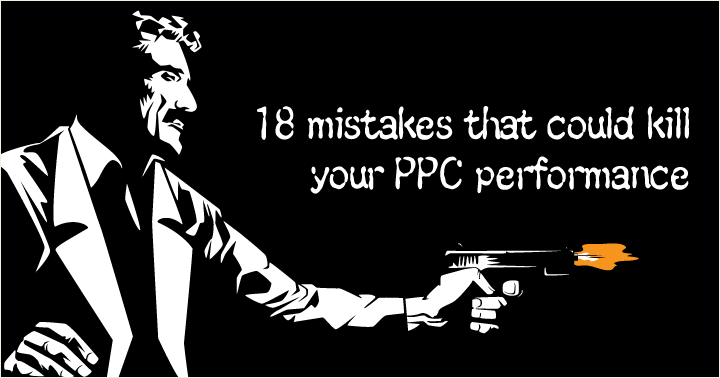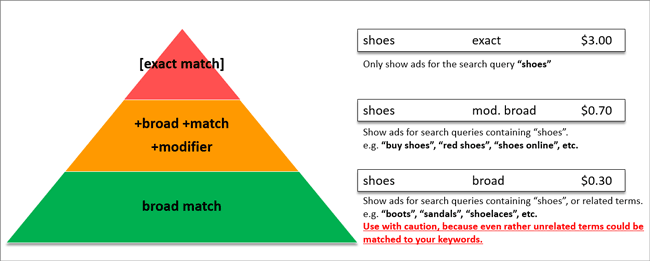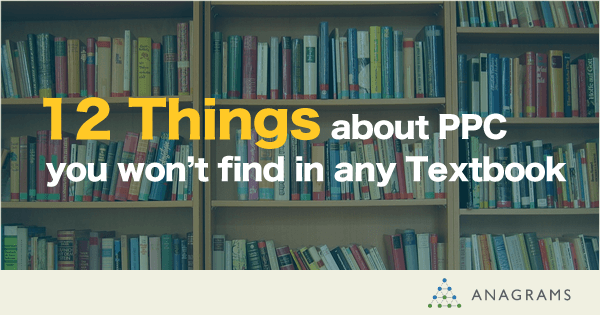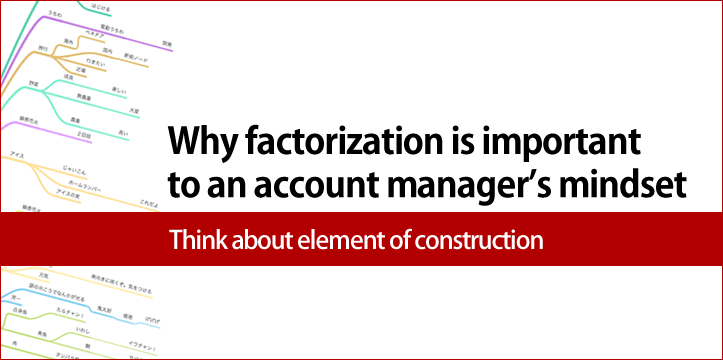
Anybody who has invested a lot of time in building a PPC account will have probably gone through the unrewarding experience of things not quite working out as expected. The truth is, it's actually these little mistakes that often prevent you from getting the best out of your account. And such mistakes come in plenty of varieties.
So this time we want to show you 18 common mistakes that could possibly kill your account (or its potential) and how to deal with them.
※This is a translation of the this article.
目次
Mistakes in the budget settings
PPC is just like asset managing: In order to maximize your earnings within a limited budget, it is essential to think about what amount you should allocate to which campaign. And this has to happen in a very short cycle.
Here we will show you how the budget settings could get your account's performance into trouble.
1. Missing opportunities through wrong budget settings
Mistakes in the campaign budget settings are very common. Even if you are running a very cost-effective campaign, if its daily budget is set too low, your ads are missing out on chances to be shown, which could eventually lead to lost conversions and earnings.
For example, if a campaign's daily budget was set too low, it will very likely get close to its limit in the evening hours, resulting in your ads getting shown less and less. Just imagine what would happen if your business was mainly focused on generating traffic, sales or leads at this time of the day. A lot of potential business would just go down the drain, and wouldn't that be a waste?
The same could also occur with "shared budgets" in Google AdWords if you are being too restrictive with your whole account's daily budgets.
2. Mistakes in your marketing portfolio
Problems in the budget portfolio are also very common Like when there is one fixed budget for each marketing channel (a certain amount for Google, another one for Bing, etc.) Or when mistakes are made in the distribution of monthly budgets (it being tied to a strict annual plan, or when there is a fixed daily amount to be spent, etc.) Or even when there are fixed budgets for each channel (one amount for search ads, one for remarketing, etc.) So be especially careful when your media budgets are determined very strictly.
However, in large scale companies it is a pretty common practice to decide over a budget plan in advance. In such a case, don't just accept your fate, but try to create an environment which allows you to be as flexible in budget allocation within the given boundaries as possible.
What we would like to stress the most here is the following: Not being able to shift budget to a well-performing channel due to restrictions (in the monthly amount or by channel) is in fact happening very often in many accounts.This is a common problem for account managers as well as for the organization itself.
A budget shift at the right time to the right marketing channel will most likely boost your sales, so it's always better to be able to manage your media budget as flexibly as possible.
Mistakes in account structure
You will probably already have had the experience of building a complex account and yet, the actual performance might not live up to its expectations, or ads will show up when they aren't supposed to.
Here we want to show you the mistakes in account structure that could kill your PPC performance.
3. Not using the matching types correctly
For example, solely relying on one matching type like “exact" or “broad" would be such a case.
As the term already suggests, an account only consisting of “exact match" keywords would always require a search query to exactly match one of your keywords to actually have an ad displayed. While in fact retaining full control over your keyword bids, the drawback here is, that you won't be able to cover any topics beyond your keywords and you will miss out on chances to discover new search terms that might be relevant to your business. An account exclusively using “broad match" for all keywords, on the other hand, will significantly expand the range of search terms that can trigger your ads, but yet make it very difficult to control your bids for those queries that perform well, which will negatively impact the overall cost-efficiency.

Both matching types have their fair share of benefits and downsides, so it is crucial to understand how they work and which role they can play in order to use them more wisely in your marketing strategy.
4. Mistakes in the campaign settings
The mistakes we encounter the most are the ones in the local settings and ad scheduling.
For instance, this would be the case when running PPC ads for a local business where the ads would get shown even in regions where the advertised service isn't available.
Another example would be a campaign to drive phone call conversions, which for no particular reason continues to show ads outside of the business-hours with nobody available to take the calls. Also, when you are clustering your campaigns regionally by implementing designated local targeting to each of them, keep in mind that even if in sum you are covering all of the relevant regions for your business, there will always be users within the selected areas whose location cannot be specified, and therefore fall into the “unknown" category. Since in such a setup those users won't see your ads, it could result in missing out on valuable business opportunities. So in order to take care of that matter, we suggest creating a separate campaign exclusively targeting these “unknown" users, and in which all the specified areas you already are covering with your other campaigns are excluded.
5. Unwanted ad impressions
When the balance in your keyword bids gets out of hand, or your broad match keywords get matched to irrelevant search queries, ads are being shown even when
you don't want them to. At worst you accumulate a lot of low quality traffic that is mostly unimportant for your business.
When broad match keywords respond to undesired search queries, have a look at the Search Terms Report and add new negative keywords to cut down ad impressions for irrelevant searches.But also be careful to select the correct match type and not to use keywords you actually want to bid on as negatives. This will ensure that you are not reducing the impressions that you are actually aiming for.
6. Choosing the wrong landing page URL
This is the case when you assign the same landing page URL to everything in your account, and/or all of your links in use direct to the homepage for no particular reason.
To determine where to link to, it is important to make a split test between several different landing pages to find out which one actually affects your performance the
most.
7. Making it hard to optimize display ads
This occurs when you use your keywords simultaneously for the search and the display network.
Mixing keyword-targeted search ads and contextual targeting into one single campaign is not a good idea, because they rely on different mechanics and require different means of optimization. Our recommendation therefore is to manage each in separate campaigns.
8. Mistakes in the targeting settings
The following cases are very common mistakes in managing display campaigns.
Not excluding Converted Users from your display targeting:
If you pursue a strategy specially focused on returning customers, it's a whole different story, but for campaigns that are aiming for new business we suggest to exclude users who have already completed a conversion.
Setting negative keywords within interest based targeting:
Again we're not talking about special cases here, but since interest-based targeting applies to certain users and is not based on website content, it would be counterproductive to use (contextual) negative keywords here.
Your remarketing campaigns are targeting “all users" and/or the cookie lifetime is set to default:
Often your most recent visitors are the ones who are most likely to convert, and with every passing day the probability that they will convert will decrease.
In campaigns that are already generating many conversions per day, you could use the Conversion Optimizer to take the time period after a user has visited your website into consideration for your bidding strategy - even if the cookie lifetime is set to the default value of 30 days. But why not take it further and even control the bids for all the other campaigns, by segmenting your lists by the elapsed time after a user visited your website and adjusting the bids accordingly for each separate time interval.
Mistakes in the Settings for “Targeting Optimization" and “Flexible Reach":
These enhanced targeting settings are actually activated by default. But since they can result in unnecessary ad impressions, we recommend to deactivate them when starting out. Consider using them after having accumulated a sufficient amount of conversions.
Not paying attention to your ads
Ads are an important means to appeal to audiences that are valuable to your business.
Even when having a solid account structure, you won't do yourself any favors if you are not taking care of your ads. That's why here we would like to show you how your ads could pose a threat to your performance if not looked after properly.
9. The ad copy is not well thought out
Regarding ad copies, there are several things that should be avoided:
- Not including your USP (Unique Selling Proposition) in your ad copies due to lack of awareness of your own products/services or those of your competitors.
- Having built up an optimized ad group structure, still using identical ad texts everywhere.
- Almost forcing your keyword to appear in your ad text and ending up with an ad copy that just sounds awkward.
- Or ad texts that don't seem to fit a certain phase of the conversion funnel. Just to name a few.
Try to address something where you are ahead of your competition. Have your ad copies thematically match your keywords, but don't force it for the mere reason that you have separated them in to different ad groups. And keep in mind how to best appeal to users in each phase of the conversion funnel. This can drastically uplift your performance. Don't forget that ads aren't just about getting clicks, but provide a powerful trigger to generate new customers.
10. Not A/B-testing your ads
A/B-testing is one indispensable way to boost your conversions.
Always have 2 to 3 ads running at a time and keep on testing. And don't hesitate to even go beyond A, B or even C - why not aim for Z if that works best for your campaigns?
11. Not using enough types of ads
That would be the case if you used only image ads or only text ads or just a few banner formats.
Since text and image ads have their designated spots where they appear, we recommend using both types, because otherwise you could risk not reaching your audience properly. When talking about banner sizes, it would of course be best to offer all available formats, but even in a limited setup try to get the biggest impact out of every impression by letting the larger image banner formats take priority.
12. Not using any ad extensions
Your Ad Rank substantially impacts your position and the actual CPC, and is determined by “Quality Score * Max. CPC (+ Ad Extensions)".
Ad Extensions will definitely benefit your Ad Rank, so unless there are any specific strategic reasons against ad extensions (e.g. only wanting to lead traffic to one single landing page), we highly recommend to make wide use of them.
Too much and too less
When you are overdoing things or just aren't doing enough - Putting a lot of effort into complex settings can lead to performance uplifts, however at a certain level, the time invested won't pay off, or everything could even turn out worse than it was before.
That's why right judgement is the key to everything. And that is what actually makes an expert account manager stand out from the crowd.
13. Excessive or insufficient tweaking
The following examples show situations where it is taken into either extreme.
Negative Keywords:
Adding a lot of negative keywords without thoroughly checking them and the Search Terms Report beforehand might actually backfire and could block important keywords and related searches. On the other hand if you are using too few negatives, your keywords will trigger ads when they shouldn't be.
Only one keyword per ad group:
Provided such a structure is following a designated strategic purpose, then this wouldn´t be overly problematic. Of course, the larger and more complex your keyword set gets, the more tedious campaign management can become. But even so, we wouldn´t recommend such a structure unless it is deemed strategically necessary.
Setting an Audience List's membership duration to 1 day or building too many lists for each page:
User data will be scattered across too many lists, risking your ads not being able to meet the minimum criteria to be shown to users.
Extreme frequency cap settings:
It's a lose-lose situation for your business when the settings are too extreme here. Ask yourself if frequency capping is really necessary or if there isn't anything else that could be done. Try to implement it only when it's really needed.
Excessive use of adjustments for location, device, time, etc:
If you tweak many parameters at such a detailed level, then you inevitably create a lot of things that you will have to frequently review and re-adjust. Since this can be very time consuming, double check if you have your priorities in the correct order, so you don't waste time that could be spent on other optimizations.
About the PDCA-cycle
Not reflecting on implemented measures or not testing new concepts and features and just leaving your account the way it is can lead to stagnation or even a worsening of your campaign performance.
14. Not making use of detailed reports
With detailed reports we generally mean reports for “Device", “Search Terms" and “Placements". These reports let you check the performance by device, or if ads were shown for undesired search terms and placements. But they also allow you to discover new keywords or placements that haven't been on your radar yet. We highly recommend to include these reports in your regular Monday and Friday working routines.
Detailed reports tend to get overlooked, because the basic reports in the AdWords interface appear slightly more accessible, but it's definitely worth the little extra effort. So always have their potential in mind when optimizing your campaigns.
15. Not trying something new
Imagine only running search ads, or using display ads - but only remarketing. Or how about only advertising on Google but not on Bing - those are the problems we would like to address now.
Even if you only focused on remarketing, you could build a list of Similar Audiences based on the Converted Users to expand your targeting. Also the aforementioned
Placement Report could open up new potential audiences to be targeted. So there still should be a lot of things you could do. For example, it's actually not uncommon to gain many new business opportunities through smart use of the Converted Users list.
Paid Search is the most typical of all online marketing channels. And if you understand it as a form of investment management, there is no reason not to challenge new things in order to boost your sales. And it doesn't even take a lot of budget to start out.
16. Getting lazy after measures are implemented
For instance, you have finally set up your account and did your first fine-tuning, but then after everything was implemented you fall into a false sense of security
and fail to carry out further performance checks. We have collected the most common pitfalls here.
Relying too much on bidding features (e.g. Conversion Optimizer or Automated Rules, etc.) and having everything on “autopilot":
This can result in sudden overspending, impressions lost for your most important keywords, and other unexpected effects.
Not checking your keyword's status/your ads are not shown in a top-position:
After activating your keywords, use the Ad Preview Tool to ensure you haven't overlooked any mistakes.
Mistakes in your device targeting:
This often happens with display ads – for example, accidentally targeting smartphones when you actually intended to only target desktop PCs is a common case.
Organizations
At first glance, the organization of the operation team doesn't appear to impact your account directly, but the following mistakes could lead to missed chances for
optimization or even to a deterioration of your account.
17. Team structure issues
This happens when too many people are working on one project, or when internal and external rules get your account's performance into trouble. The following examples are rather common.
Dividing each task (account setup, management, reporting and sales) among several staff members:
The more people that are involved, the more communication costs will rise, while everything is also more prone to misunderstandings and subsequent mistakes.
Excessively splitting up accounts:
This is the case when there is one account for each marketing channel (search ads, display, etc.) and one for each device (PC, tablet and smartphone), and so on. If you divide every account into such levels, all the operative tasks and optimization measures have to be completed once for each account, which will certainly result in reduced efficiency.
Not being granted full rights to analytics platforms or tag management:
One very negative scenario could be a situation where you need certain data to measure and optimize your ad performance, but for some reason the department in
charge isn't cooperating as they should. This should go without saying, but with nobody willing to provide you the requested data, or to implement the necessary tags, it will be impossible to properly evaluate your ad performance.
18. Overcomplicating your tasks
Managing an account is accompanied by several other tasks that alone can create a huge workload that could possibly become exhausting. The following is just an example, but it should stress the importance of always questioning the necessity of each task before requesting for it to be carried out.
Creating and attaching many tracking parameters:
Being able to track everything individually at an ad or keyword level is a tempting idea – we understand that very well. However, since this would require creating and attaching thousands of parameters to your keywords and creatives each time you add some new ones to your account, it is a very tedious task. In addition to that, it can cause each performed action to take more than twice as long as usual (creating parameters, checking, uploading, making adjustments, checking again, etc.).
This creates a lot of risks for your performance that might not be that obvious at first sight.
Requesting too many reports too often:
From an advertiser's point of view, you would want to know how your campaigns are doing. But if report requests exceed a certain amount, it will be tiresome for those who have to create them. What you need to do is always re-examine whether or not a report is really necessary for your management decisions.
And only third-rate account managers would refuse to create a report that would be really vital to a decision making process.
Excurse: Myths and Urban Legends
As an excurse to the “18 Mistakes", we would also like to highlight some PPC Myths and Urban Legends that could have a negative impact on your account's performance.
Appendix 1. Getting too obsessed with quality score.
Since the quality score is one important factor for determining the ad rank, the notion of “a higher quality score lowering the click price" is something people in PPC tend to get very obsessed about. In extreme cases, people even believe that “a higher quality score will even contribute to sales".
However, for this theory to be true it is required that the competitor's ad rank (including quality score and Max CPC) and your own position are not subject to change. Only then you would pay less for maintaining the same position.
Of course it is correct that click prices will more likely get cheaper when your Quality Score gets higher. But it is also a fact that your click price is even more influenced by the ad that's below yours, so at the end of the day, all time and effort put into improving quality score often might not pay off that much or in some cases not even pay off at all.
If you say your main goal was to increase sales, you shouldn't get too obsessed with quality score. Instead it would be smarter to think about how you could drive more conversions, or if there isn't another way to lower your CPA apart from lowering your click prices.
Appendix 2. Treating keyword count like a KPI
The more keywords there are in use, the more it might give you a feeling of “really getting serious with PPC". However, are all the newly added keywords really necessary in terms of being beneficial to your business? What if the vast majority of your keywords aren't even generating any impressions at all? Then keyword count alone won't qualify as a valid KPI. Adding new keywords is by no means a waste of time, but always ask yourself if there aren't any other more important things to do.
Even without adding new keywords, making clever use of Dynamic Search Ads (DSA) or Google Shopping Campaigns/PLA will provide you with many possibilities to get your creatives matched to relevant search queries.
As a side note, also keep in mind that the aforementioned quality score will not have any meaningful value anyway as long as a keyword hasn't generated any impressions yet.
Appendix 3. Meaningless position bidding
Some advertisers might try to precisely determine on which position to bid. But in the end, since the position depends on CPC bids, it will be virtually impossible to always maintain the desired position. (You can have some control over it with certain bidding strategies in Google AdWords, but you cannot determine it exactly)
In fact, there are some rare cases when, depending on your business and competitive set, your ad will perform best at one specific position. Hence in some cases advertisers might immediately contact the account manager when there is a slight change in position.
However, being excessively concerned just about position, cannot be a worthwhile thing to do if it keeps you from doing other important tasks.
Conclusion
There you have it - the 18 mistakes that could kill your account. The expression “18 mistakes" may indeed sound very negative at first, but if you turn everything inside-out, it could also be read as “18 measures that will benefit your account".
We hope that this article will provide you with a useful reference for your daily campaign management, and has made you think about “whether or not you are killing your account", or “where to actually look for when you are trying to increase sales".
Translated by Jan Hugendick










